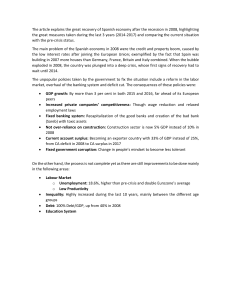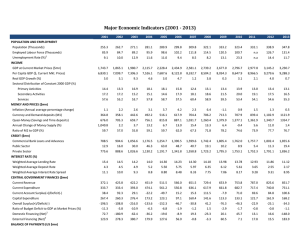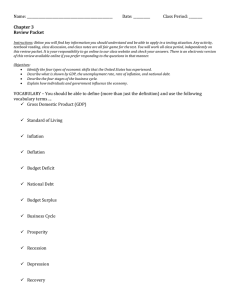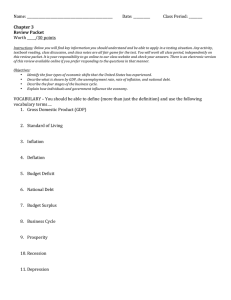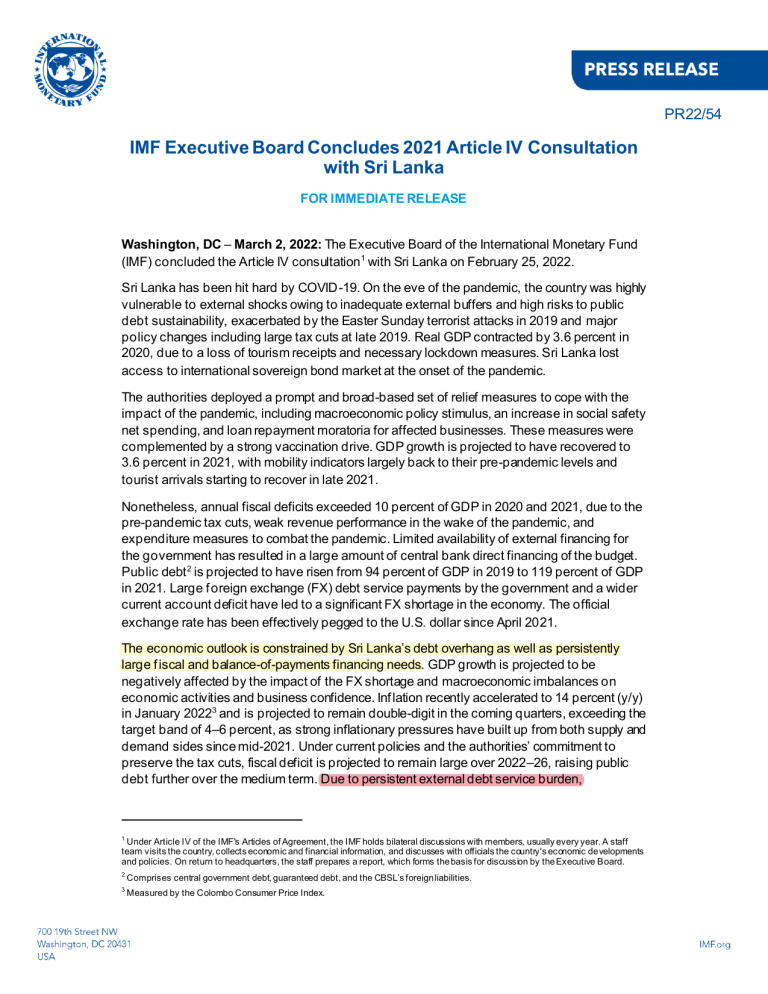
PR22/54 IMF Executive Board Concludes 2021 Article IV Consultation with Sri Lanka FOR IMMEDIATE RELEASE Washington, DC – March 2, 2022: The Executive Board of the International Monetary Fund (IMF) concluded the Article IV consultation1 with Sri Lanka on February 25, 2022. Sri Lanka has been hit hard by COVID-19. On the eve of the pandemic, the country was highly vulnerable to external shocks owing to inadequate external buffers and high risks to public debt sustainability, exacerbated by the Easter Sunday terrorist attacks in 2019 and major policy changes including large tax cuts at late 2019. Real GDP contracted by 3.6 percent in 2020, due to a loss of tourism receipts and necessary lockdown measures. Sri Lanka lost access to international sovereign bond market at the onset of the pandemic. The authorities deployed a prompt and broad-based set of relief measures to cope with the impact of the pandemic, including macroeconomic policy stimulus, an increase in social safety net spending, and loan repayment moratoria for affected businesses. These measures were complemented by a strong vaccination drive. GDP growth is projected to have recovered to 3.6 percent in 2021, with mobility indicators largely back to their pre-pandemic levels and tourist arrivals starting to recover in late 2021. Nonetheless, annual fiscal deficits exceeded 10 percent of GDP in 2020 and 2021, due to the pre-pandemic tax cuts, weak revenue performance in the wake of the pandemic, and expenditure measures to combat the pandemic. Limited availability of external financing for the government has resulted in a large amount of central bank direct financing of the budget. Public debt 2 is projected to have risen from 94 percent of GDP in 2019 to 119 percent of GDP in 2021. Large f oreign exchange (FX) debt service payments by the government and a wider current account deficit have led to a significant FX shortage in the economy. The official exchange rate has been effectively pegged to the U.S. dollar since April 2021. The economic outlook is constrained by Sri Lanka’s debt overhang as well as persistently large f iscal and balance-of-payments financing needs. GDP growth is projected to be negatively affected by the impact of the FX shortage and macroeconomic imbalances on economic activities and business confidence. Inf lation recently accelerated to 14 percent (y/y) in January 20223 and is projected to remain double-digit in the coming quarters, exceeding the target band of 4–6 percent, as strong inflationary pressures have built up from both supply and demand sides since mid-2021. Under current policies and the authorities’ commitment to preserve the tax cuts, fiscal deficit is projected to remain large over 2022–26, raising public debt further over the medium term. Due to persistent external debt service burden, 1 Under Article IV of the IMF's Articles of Agreement, the IMF holds bilateral discussions with members, usually every year. A staff team visits the country, collects economic and financial information, and discusses with officials the country's economic developments and policies. On return to headquarters, the staff prepares a report, which forms the basis for discussion by the Executive Board. 2 Comprises central government debt, guaranteed debt, and the CBSL’s foreign liabilities. 3 Measured by the Colombo Consumer Price Index. 2 international reserves would remain inadequate, despite the authorities’ ongoing efforts to secure FX f inancing from external sources. The outlook is subject to large uncertainties with risks tilted to the downside. Unless the fiscal and balance-of-payments financing needs are met, the country could experience significant contractions in imports and private credit growth, or monetary instability in case of further central bank financing of fiscal deficits. Additional downside risks include a COVID-19 resurgence, rising commodity prices, worse-than-expected agricultural production, a potential deterioration in banks’ asset quality, and extreme weather events. Upside risks include a f aster-than-expected tourism recovery and stronger-than-projected FDI inf lows. Executive Board Assessment4 Executive Directors commended the Sri Lankan authorities for the prompt policy response and successful vaccination drive, which have cushioned the impact of the pandemic. Despite the ongoing economic recovery, Directors noted that the country faces mounting challenges, including public debt that has risen to unsustainable levels, low international reserves, and persistently large financing needs in the coming years. Against this backdrop, they stressed the urgency of implementing a credible and coherent strategy to restore macroeconomic stability and debt sustainability, while protecting vulnerable groups and reducing poverty through strengthened, well-targeted social safety nets. Directors emphasized the need for an ambitious fiscal consolidation that is based on highquality revenue measures. Noting Sri Lanka’s low tax-to-GDP ratio, they saw scope for raising income tax and VAT rates and minimizing exemptions, complemented with revenue administration reform. Directors encouraged continued improvements to expenditure rationalization, budget formulation and execution, and the fiscal rule. They also encouraged the authorities to reform state-owned enterprises and adopt cost-recovery energy pricing. Directors agreed that a tighter monetary policy stance is needed to contain rising inflationary pressures, while phasing out the central bank’s direct financing of budget deficits. They also recommended a gradual return to a market-determined and flexible exchange rate to facilitate external adjustment and rebuild international reserves. Directors called on the authorities to gradually unwind capital flow management measures as conditions permit. Directors welcomed the policy actions that helped mitigate the impact of the pandemic on the f inancial sector. Noting financial stability risks from the public debt overhang and sovereignbank nexus, they recommended close monitoring of underlying asset quality and identifying vulnerabilities through stress testing. Directors welcomed ongoing legislative reforms to strengthen the regulatory, supervisory, and resolution frameworks. Directors called for renewed efforts on growth-enhancing structural reforms. They stressed the importance of increasing female labor force participation and reducing youth unemployment. Further ef f orts are needed to diversify the economy, phase out import restrictions, and improve the business and investment climate in general. Directors also called for a prudent management of the Colombo Port City project, and continued efforts to strengthen 4 At the conclusion of the discussion, the Managing Director, as Chairman of the Board, summarizes the views of Executive Directors, and this summary is transmitted to the country's authorities. An explanation of any qualifiers used in summings up can be found here: http://www.IMF.org/external/np/sec/misc/qualifiers.htm. 3 governance and fight corruption. They noted the country’s vulnerability to climate change and welcomed efforts to increase resilience. 4 Table 1. Sri Lanka: Selected Economic Indicators, 2018–22 2018 2019 2020 2021 2022 Proj. Output Real GDP growth (percent) 3.3 2.3 -3.6 3.6 2.6 4.3 2.8 4.3 4.8 4.6 4.2 6.0 12.1 10.5 8.3 13.5 18.8 12.6 20.6 9.2 21.9 8.9 20.3 10.7 20.3 0.6 -2.0 -6.2 -4.9 -2.8 Overall balance (percent GDP) Central government debt (percent GDP) -5.3 84.2 -8.0 86.8 -12.8 101.2 -11.4 107.1 -9.6 108.6 Public debt (percent GDP) 2/ 91.0 93.6 110.0 118.9 119.9 13.0 7.0 23.4 15.4 13.9 15.9 4.2 6.5 13.8 13.0 -3.2 -2.2 -1.3 -3.8 -3.8 1.8 6,919 0.8 7,642 0.5 5,664 0.9 3,138 1.2 2,204 3.4 60.2 5.0 65.1 3.1 66.4 1.5 65.6 1.0 64.2 Prices 1/ Inflation (average, percent) Inflation (end of period, percent) Central government finances Revenue and grants (percent GDP) Expenditure (percent GDP) Primary balance (percent GDP) Money and credit Broad money (percent change) Credit to the private sector (percent change) Balance of payments Current account (percent GDP) FDI (percent GDP) Reserves (US$ millions) Reserves (months imports) External debt (percent GDP) 3/ Sources: Data provided by the Sri Lankan authorities and IMF staff estimates. 1/ Colombo CPI. 2/ Comprising central government debt, publicly guaranteed debt, and CBSL external liabilities (i.e., Fund credit outstanding and international currency swap arrangements). 3/ Valued at face value.

